![]()
![]()
![]()
Use LEFT and RIGHT arrow keys to navigate between flashcards;
Use UP and DOWN arrow keys to flip the card;
H to show hint;
A reads text to speech;
35 Cards in this Set
- Front
- Back
|
enterics
|
gram negative bacteria common to or occurring as pathogens in the intestinal tract. Does not include all gut bacteria.
|
|
|
enterobacteriaceae
|
taxonomic family of gram-negative, facultative anaerobic rods, most of which are motile with periticious flagella and oxidase negative.
Include most but not all enterics. Can infect any body site. Does not include all gut bacteria. Do not all live in the gut. |
|
|
Physical Characteristics of Enterobacteriaceae
|
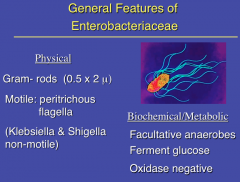
Gram Negative
Rods Motile- Periticious Flagella (come out all around periphery of cell) (Klebsiella and Shigella are non-motile) |
|
|
Biochemical/Metabolical Characteristics of Enterobacteriaceae
|
1. Facultative Anaerobes
-Uses O2 if its there, can ferment if its not. Distinguishes this family from other bacteria in the gut that are obligate anaerobes. 2. Ferment Glucose 3. Oxidase Negative -many bacteria that infect the GI tract are oxidase positive, the enterics are not. Upon addition of an oxidase reagent, they do not change color because they cannot use O2 for energy production) 4. Lactose Fermentation -many of the classic enteric pathogens cannot ferment lactose (Lac-). However, commensal Escherechia are lac positive, and this distinguishing feature may be used to detect fecal coliforms (gut bacteria) as an indication of contamination of water etc. Lac positive colonies appear red-pink on McConkey agar. 5. Bile Salts -select for growth of certain enteric bacteria. Used in combination with lactose to distinguish enteric pathogens in stool samples. |
|
|
serotyping
|
after speciation, serotyping is used to further differentiate bacteria.
O-Antigen: lipopolysaccharide H-Antigen: Flagellum K-Antigen: Capsules (in gram negative bacteria) (In Salmonella we call the capsule the Vi antigen or virulence antigen) |
|
|
E. Coli (EHEC)
|
member of family Eneterobacteriaceae ("enterics")
Gram-Negative Rod Most abundant facultative anaerobe in the gut |
|
|
E. coli Epidemiology
|
EHEC refers to E. coli serotype O157:H7
It is the cause of hemorrhagic colitis, which presents as bloody diarrhea. |
|
|
How is EHEC (E. coli) acquired?
|
Reservoir: Cattle and other grazers (does not cause disease in them)
Transmission Route: fecal-oral Transmission Vehicles: food, water, animal contact, human contact Low infectious dose!! EHEC has a low infectious does because it is resistant to stomach acid. |
|
|
what body abnormalities would increase your susceptibility to EHEC (E. coli) infection?
|
Reduced stomach acidity increases susceptibility to infection
Stomach acid provides strong barrier to intestinal infection. Acid resistant intestinal pathogens have lower infectious doses. |
|
|
E. coli: Progression of Infection
|
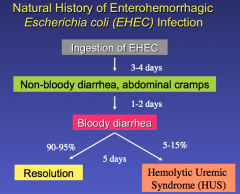
EHEC has an incubation period of about 3-4 days when you will still feel okay,
At the 3 or 4 day make you will begin experiencing diarrhea and abdominal cramps 1-2 Days later you will get the bloody diarrhea characteristics of EHEC For most people, it will spontaneously resolve in about 5 days. But a very small subgroup will develop Hemolytic Uremic Syndrome (HUS) |
|
|
How does E. coli cause the abdominal cramps and non-bloody diarrhea seen at the onset of infection?
|
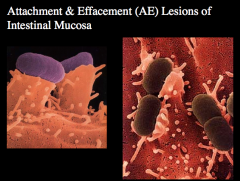
"ATTACHMENT AND EFFACEMENT LESIONS OF THE INTESTINAL MUCOSA"
EHEC attach to the intestinal brush border and inject proteins into epithelial cells in order to take over. They induce the intestinal walls to form pedestals which bind tightly to the bacteria (attachment) while also leading to the loss of microvilli (effacement), which leads to a loss of the absorptive capacity they are responsible for. Loss of this absorptive capacity contributes to diarrhea. |
|
|
How does E. coli cause bloody diarrhea?
|
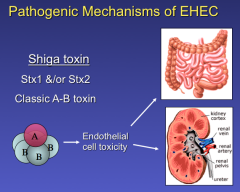
EHEC inject Shiga Toxin into epithelial cells. It binds to receptors abundant int he intestinal capillaries and leads to destruction of intestinal epithelial cells, producing bloody diarrhea.
Shiga toxin is an A-B toxin. B subunits bind to capillary endothelium and A subunit destroys it. This is what causes the bloody diarrhea. |
|
|
How can E. coli cause Hemolytic Uremic Syndrome (HUS)?
|
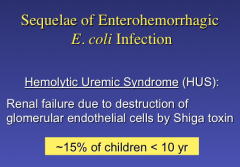
Shiga toxin gets into the blood stream and targets the kidney. It can cause renal failure by destroying the glomerular endothelial cells.
|
|
|
Identifying E. coli on McConkey-Sorbital plate
|
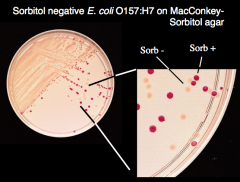
O157:H7 cannot ferment sorbitol, and therefore can be distinguished from other enteric strains by using McConkey agar plus sorbitol.
This plate has a red dye that will label colonies fermenting Sorbitol. E. Coli O157:H7 is Sorb(-) and is highly likely to be the source of any clear colonies |
|
|
Salmonella
|
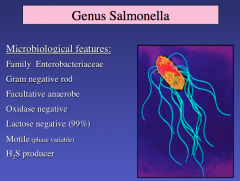
Type of Enterobacteriaceae
Gram Negative Rod Facultative Anaerobes Oxidase Negative Lactose Negative Motile Produce Hydrogen Sulfide (H2S) |
|
|
Species of Salmonella
|
Only 2 Species.
1. Enterica 2. Bongori Enterica has 6 subtypes |
|
|
Salmonella: Broad Host-Range
|

serotypes capable of infecting a wide range of hosts, including mammals, birds, and even reptiles. These organisms can infect humans and produce typical diarrheal disease, Gastroenteritis.
|
|
|
Gastroenteritis
|
inflammation of intestines
-associated with diarrhea and cramping -usually mild and self resolves in a few days Due to Salmonella Enterica (broad host-range serotypes) Reservoir: GI tract of animals, birds, reptiles Transmission Route: fecal-oral Transmission Vehicles: poultry, eggs, contaminated food |
|
|
Salmonella: Narrow host-range
|
serotypes are specifically adapted to a preferred host and rarely manifest as gastroenteritis*
|
|
|
Salmonella Enterica serotype Typhi (Salmonella Typhi)
|
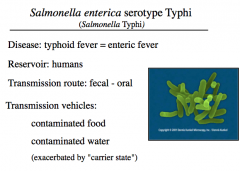
narrow host range serotypes
humans are ONLY known reservoir! can become a chronic infection of the gallbladder in some people, making them asymptomatic carriers of the bacteria. So ti flows out into their feces and then gets into food. |
|
|
Pathogenesis of Salmonella Gastroenteritis
|
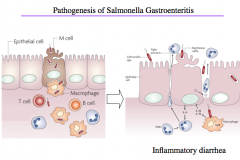
Salmonella are invasive bacteria (unlike E. coli!)**
they invade the intestinal mucosa via M cells and induce a strong inflammatory response by inducing cytokine production in macrophages and epithelial cells. Massive neutrophil infiltration* occurs, and when neutrophils squeeze out into the lumen they destroy the tight junctions between epithelial cells, allowing for the loss of fluid which causes diarrhea. (inflammatory diarrhea*) |
|
|
Pathogenesis of Typhoid Fever
|
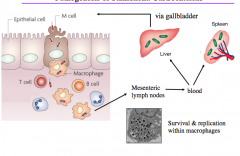
typhoid fever is caused by invasive Salmonella that invade M cells, similar to gastroenteritis. however, these bacteria are unable to be properly killed upon phagocytosis by macrophages.
When the infected macrophages drain to the mesenteric lymph nodes and into the blood, the bacteria may lyse the macrophage rendering the patient bactermic- this causes fever When the phagocyte ruptures, Salmonella Typhi is released systemically. The macrophages give them a transport system. |
|
|
Genus Shigella
|
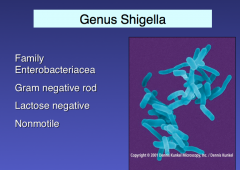
nonmotile**
there is no commensal shigella, so it is also a PRIMARY PATHOGEN can be distinguished from Salmonella infections by the fact that it is *incapable of producing H2S* |
|
|
Shigella Species
|
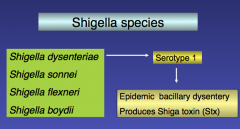
all 4 species can cause dysentry
the most severe form of dystentery is caused by S. dysenteriae Serotype 1 (S. dysenteriae) is the only serotype that can produce Shiga Toxin |
|
|
Shigellosis
|
mild to severe diarrhea (may be bloody)
abdominal pain, fever, malaise |
|
|
Shigellosis Dysentery Syndrome
|
cramps
tenesumus (always thinking you need to poop) frequency small volume, bloody, mucus discharge |
|
|
Shigella Epidemiology
|
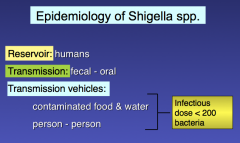
human are ONLY reservoir!
transmission vehicles: 5 F's (food, fingers, feces, flies, fomites) |
|
|
Shigella Pathogenesis
|
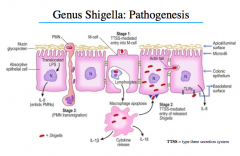
Shigella are invasive bacterium (like Salmonella; unlike E. coli)**
enter vie M-Cells. Can hijack cytoskeleton actin filaments of the cell to push themselves from one cell to the next even tho they are non-motile. This results in a focal infection that spreads laterally through the epithelia, and increasing levels of bacteria/neutrophils will kill the cells. The dead epithelia sloughs off and will be a detectable component of the small volume discharges associated with shigella dysentery. |
|
|
Shigella Dysenteriae Type 1 serotype
|
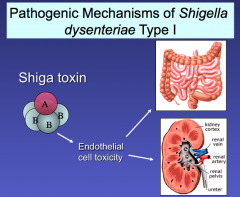
has Shiga Toxin dun dun DUN!
so it can cause Hemolytic Uremic Syndrom (HUS), just like E. Coli |
|
|
Campylobacter
|
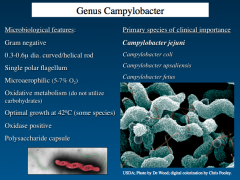
NOT a member of Enterobacteriaceae.
They are the most common cause of GU infections! Gram Negative Super Small Helical Rod Single polar Flagellum Microaerophilic (need oxygen, but die if they get too much) Oxidative Metabolism (don't use carbs) Grow at slightly warmer temperatures *Oxidase Positive (enterobacteriaceae are oxidase negative) Some have Polysaccharide Capsule |
|
|
Epidemiology of Campylobacter Jejuni
|
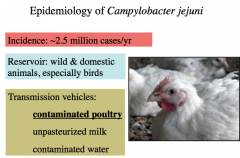
Reservoir: especially birds because they have a higher body temp (42 degrees) which is conducive to this bacteria
|
|
|
Age Distribution of Enteric Infections
|
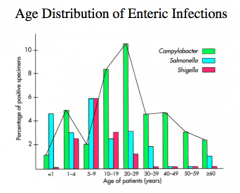
Salmonella- highest in kids under 1, then drops off, and picks up when they go to school, then drops off again.
Shigella- highest in age group 5-9, then drops off. Campylobacter- seen in 1-4 year olds, then drops off. Spikes in twenties** before dropping down. More common in men, associated with improper skills in the kitchen. |
|
|
Campylobacter: Pathogenesis
|
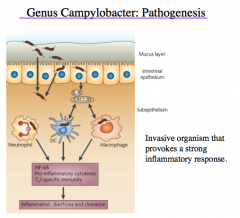
INVASIVE!
Gets phagocytosed and transmitted to the bass-lateral side, just like we saw with Salmonella Transgresses the epithelial barrier, provoking a strong inflammatory response (which leads to diarrhea and cramping) |
|
|
Sequela of Campylobacteriosis
|
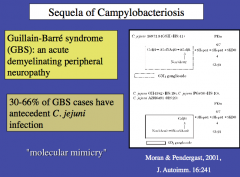
Sequelae is a secondary pathological condition resulting from infection
associated with Guillian Barre syndrome. - a lot of times, this syndrome is preceded by Campylobacter Jejuni infection |
|
|
Relative Incidence of Enteric Infections
|

Campylobacter > Salmonella > Shigella >> EHEC
|

